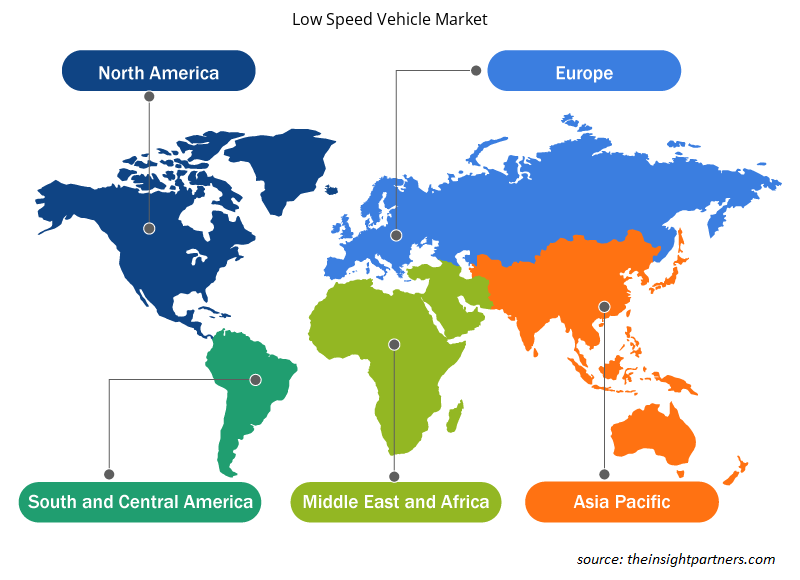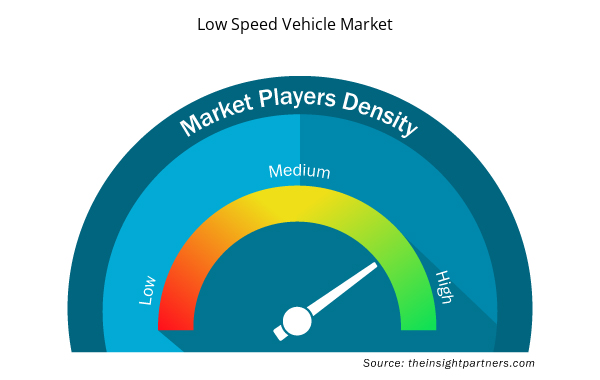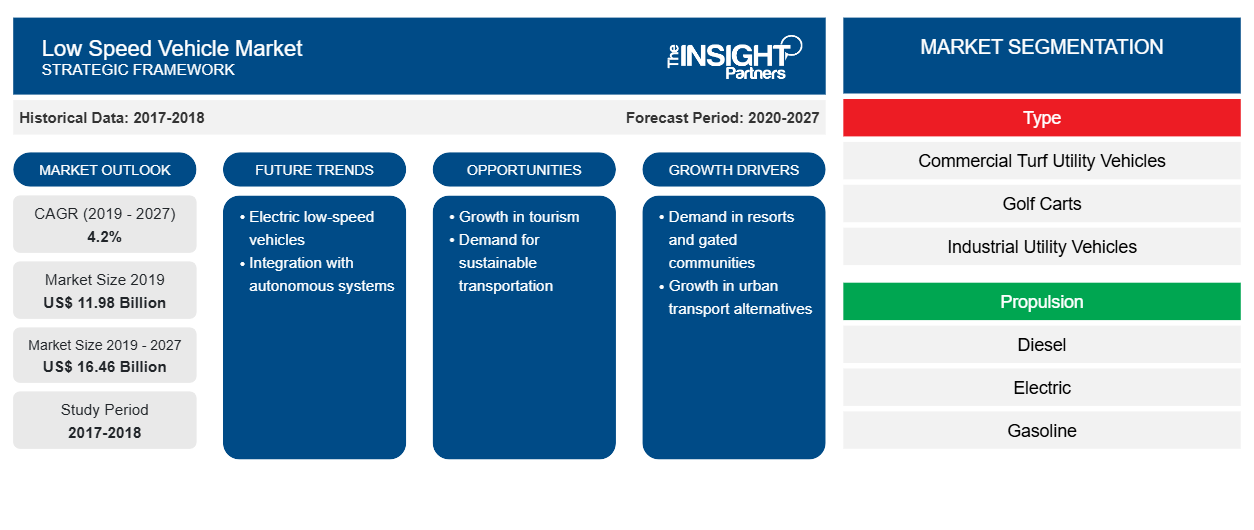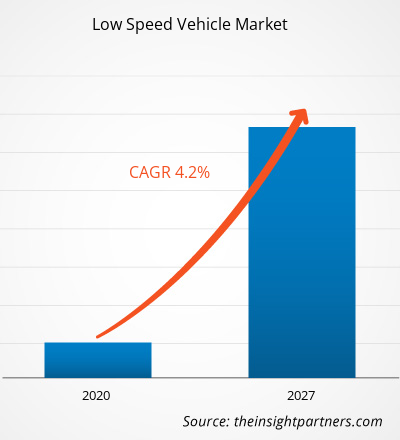Nel 2019 il mercato dei veicoli a bassa velocità è stato valutato 11,98 miliardi di dollari USA e si prevede che crescerà a un CAGR del 4,2% dal 2020 al 2027, raggiungendo i 16,46 miliardi di dollari USA entro il 2027.
Il mercato dei veicoli a bassa velocità ha assistito a una crescita eminente negli ultimi due anni a livello globale. Le prospettive economiche positive, l'aumento dei redditi disponibili e la crescita della popolazione sono tra i fattori che stanno guidando la domanda di progetti infrastrutturali. Inoltre, per quanto riguarda l'elevato volume di ordini online, il settore dell'e-commerce sta crescendo, il che si tradurrebbe in una maggiore proprietà di magazzini nella regione. I veicoli a bassa velocità all'interno del magazzino supportano lo spostamento delle scatole da un luogo all'altro. I fattori sopra menzionati svolgono un ruolo importante nell'accelerazione della crescita del mercato dei veicoli a bassa velocità . L'APAC ha detenuto la quota di mercato più grande nel 2019 e si prevede che sarà la regione in più rapida crescita nel mercato dei veicoli a bassa velocità. Il Nord America e l'Europa sono la seconda e la terza regione più grande nel mercato della bassa velocità.
L'epidemia di coronavirus è iniziata a Wuhan (Cina) nel dicembre 2019. Si è diffusa a un ritmo rapido in tutto il mondo e alcuni dei paesi più colpiti includono Cina, Italia, Iran, Spagna, Repubblica di Corea, Francia, Germania e Stati Uniti. L'epidemia di COVID-19 e i suoi effetti conseguenti come blocchi delle frontiere, chiusure, divieti di viaggio hanno iniziato a influenzare le aziende in vari settori. Si prevede che il mercato dei veicoli a bassa velocità avrà un impatto medio a causa delle interruzioni nelle catene di fornitura globali. Le aziende che operano in questo mercato vedranno un calo delle vendite complessive nel breve termine (3-6 mesi), tuttavia, il mercato vedrà una crescita costante nei prossimi anni.
Personalizza questo report in base alle tue esigenze
Riceverai la personalizzazione gratuita di qualsiasi report, comprese parti di questo report, o analisi a livello nazionale, pacchetto dati Excel, oltre a usufruire di grandi offerte e sconti per start-up e università
- Scopri le principali tendenze di mercato in questo rapporto.Questo campione GRATUITO includerà analisi di dati che spaziano dalle tendenze di mercato alle stime e alle previsioni.
Approfondimenti di mercato
Crescenti iniziative governative per incoraggiare il trasporto sostenibile
Unione Europea, Cina, Giappone, Canada, India e Corea del Sud sono alcune delle principali aree geografiche in cui i governi stanno adottando misure proattive per aumentare l'adozione di veicoli elettrici. Ad esempio, nell'Unione Europea, sono stati apportati miglioramenti significativi negli standard di risparmio di carburante per i veicoli esistenti. È stata formulata una "Direttiva sui veicoli puliti" per l'approvvigionamento di autobus elettrici da parte del settore pubblico. È stata inoltre formulata un'altra direttiva chiamata "Direttiva sulle prestazioni energetiche degli edifici" che stabilisce standard minimi per l'installazione di infrastrutture di ricarica negli edifici.
Approfondimenti sulla propulsione
Il mercato dei veicoli a bassa velocità, per propulsione, è segmentato in diesel, elettrico e benzina. Il segmento alimentato a carburante ha conquistato una quota dominante nel mercato globale dei veicoli a bassa velocità. C'è stata una tendenza crescente di veicoli ad alta potenza in grado di muoversi sulle strade consentite e possono essere utilizzati come veicoli di servizio e trasporto personale. Quindi, durante il periodo di previsione, si prevede che i veicoli elettrici a bassa velocità avranno una crescita significativa, insieme ai veicoli ad alta potenza a bassa velocità che a loro volta dovrebbero alla fine guidare il mercato dei veicoli a bassa velocità.
Tipo Informazioni
Il mercato dei veicoli a bassa velocità, per tipo, è segmentato in veicoli utilitari commerciali, golf cart, veicoli utilitari industriali e veicoli per il trasporto di personale. Il segmento dei golf cart ha conquistato una quota dominante nel mercato globale dei veicoli a bassa velocità. Diverse comunità negli Stati Uniti dipendono fortemente dai veicoli elettrici a bassa velocità per spostarsi. Per le persone anziane camminare può a volte essere difficile mentre guidare un'auto può essere gravoso e persino pericoloso.
Le iniziative di mercato e le nuove strategie di sviluppo sono comunemente adottate dalle aziende per espandere la propria presenza in tutto il mondo e soddisfare la crescente domanda. Queste strategie sono osservate principalmente in Nord America e in Europa. I player presenti nel mercato dei veicoli a bassa velocità adottano la strategia di espansione e investimento in ricerca e sviluppo per ampliare la base clienti in tutto il mondo, il che consente anche ai player di mantenere il proprio marchio a livello globale.
Approfondimenti regionali sul mercato dei veicoli a bassa velocità
Le tendenze regionali e i fattori che influenzano il mercato dei veicoli a bassa velocità durante il periodo di previsione sono stati ampiamente spiegati dagli analisti di Insight Partners. Questa sezione discute anche i segmenti e la geografia del mercato dei veicoli a bassa velocità in Nord America, Europa, Asia Pacifico, Medio Oriente e Africa e America meridionale e centrale.

- Ottieni i dati specifici regionali per il mercato dei veicoli a bassa velocità
Ambito del rapporto sul mercato dei veicoli a bassa velocità
| Attributo del report | Dettagli |
|---|---|
| Dimensioni del mercato nel 2019 | 11,98 miliardi di dollari USA |
| Dimensioni del mercato entro il 2027 | 16,46 miliardi di dollari USA |
| CAGR globale (2019 - 2027) | 4,2% |
| Dati storici | 2017-2018 |
| Periodo di previsione | 2020-2027 |
| Segmenti coperti | Per tipo
|
| Regioni e Paesi coperti | America del Nord
|
| Leader di mercato e profili aziendali chiave |
|
Densità degli operatori del mercato dei veicoli a bassa velocità: comprendere il suo impatto sulle dinamiche aziendali
Il mercato dei veicoli a bassa velocità sta crescendo rapidamente, spinto dalla crescente domanda degli utenti finali dovuta a fattori quali l'evoluzione delle preferenze dei consumatori, i progressi tecnologici e una maggiore consapevolezza dei vantaggi del prodotto. Con l'aumento della domanda, le aziende stanno ampliando le loro offerte, innovando per soddisfare le esigenze dei consumatori e capitalizzando sulle tendenze emergenti, il che alimenta ulteriormente la crescita del mercato.
La densità degli operatori di mercato si riferisce alla distribuzione di aziende o società che operano in un particolare mercato o settore. Indica quanti concorrenti (operatori di mercato) sono presenti in un dato spazio di mercato in relazione alle sue dimensioni o al valore di mercato totale.
Le principali aziende che operano nel mercato dei veicoli a bassa velocità sono:
- Veicolo elettrico Bintelli
- Auto Club, LLC
- Auto da crociera, Inc.,
- Deere & Società
- Società anonima HDK Co., Ltd.
Disclaimer : le aziende elencate sopra non sono classificate secondo un ordine particolare.

- Ottieni una panoramica dei principali attori del mercato dei veicoli a bassa velocità
Mercato dei veicoli a bassa velocità – Per tipo
- Veicoli utilitari commerciali per manto erboso
- Carrelli da golf
- Veicoli utilitari industriali
- Trasportatori di personale
Mercato dei veicoli a bassa velocità – Per propulsione
- Diesel
- Elettrico
- Benzina
Mercato dei veicoli a bassa velocità – Per area geografica
America del Nord
- NOI
- Canada
- Messico
Europa
- Francia
- Germania
- Italia
- Regno Unito
- Russia
- Resto d'Europa
Asia Pacifico
- Cina
- India
- Australia
- Corea del Sud
- Giappone
- Resto dell'Asia Pacifica
Medio Oriente e Africa
- Sudafrica
- Arabia Saudita
- Emirati Arabi Uniti
- Resto del Medio Oriente e Africa
Sud America
- Brasile
- Argentina
- Resto del Sud America
Profili aziendali
- Veicolo elettrico Bintelli
- Auto Club, LLC
- Auto da crociera, Inc.,
- Deere & Società
- Società anonima HDK Co., Ltd.
- Veicoli elettrici Moto
- Polaris Inc.
- Veicoli specializzati Textron Inc.
- La compagnia Toro
- Azienda di golf car Yamaha
- Analisi storica (2 anni), anno base, previsione (7 anni) con CAGR
- Analisi PEST e SWOT
- Valore/volume delle dimensioni del mercato - Globale, regionale, nazionale
- Industria e panorama competitivo
- Set di dati Excel



Report Coverage
Revenue forecast, Company Analysis, Industry landscape, Growth factors, and Trends

Segment Covered
This text is related
to segments covered.

Regional Scope
North America, Europe, Asia Pacific, Middle East & Africa, South & Central America

Country Scope
This text is related
to country scope.
Domande frequenti
In 2019, the golf carts segment led the low speed vehicle market by type and it is anticipated to continue its dominance during the forecast period of 2020 to 2027. The golf carts are available in different types, such as gas and electric golf carts. Several communities in countries like United States depend heavily on low-speed electric vehicles to get around.
Over the past few years, electric mobility has been growing at an unprecedented rate across major economies. Due to increasing concerns regarding environmental protection and favorable government policies, the sales figures of electric vehicles has seen an impressive surge in the past decade. Better fuel economy standards and zero & low emission vehicle incentives are some of the measures which are taken to lower the carbon emission level in the environment. This factor is anticipated to provide growth opportunities for the low speed vehicle market during the forecast period of 2020 to 2027.
The rising smart mobility service adoption, rapid urbanization, and increasing construction industry as well as government incentives to encourage sales of electric vehicles and high awareness regarding nonconventional fuel-driven vehicles in Asia are among the major factors boosting the low speed vehicle market growth in this region.
Trends and growth analysis reports related to Automotive and Transportation : READ MORE..
The List of Companies - Low Speed Vehicle Market
- Bintelli Electric Vehicle
- Club Car, LLC
- Cruise Car, Inc.,
- Deere & Company
- HDK Co., Ltd.
- Moto Electric Vehicles
- Polaris Inc.
- Textron Specialized Vehicles Inc.
- The Toro Company
- Yamaha Golf-Car Company
The Insight Partners performs research in 4 major stages: Data Collection & Secondary Research, Primary Research, Data Analysis and Data Triangulation & Final Review.
- Data Collection and Secondary Research:
As a market research and consulting firm operating from a decade, we have published and advised several client across the globe. First step for any study will start with an assessment of currently available data and insights from existing reports. Further, historical and current market information is collected from Investor Presentations, Annual Reports, SEC Filings, etc., and other information related to company’s performance and market positioning are gathered from Paid Databases (Factiva, Hoovers, and Reuters) and various other publications available in public domain.
Several associations trade associates, technical forums, institutes, societies and organization are accessed to gain technical as well as market related insights through their publications such as research papers, blogs and press releases related to the studies are referred to get cues about the market. Further, white papers, journals, magazines, and other news articles published in last 3 years are scrutinized and analyzed to understand the current market trends.
- Primary Research:
The primarily interview analysis comprise of data obtained from industry participants interview and answers to survey questions gathered by in-house primary team.
For primary research, interviews are conducted with industry experts/CEOs/Marketing Managers/VPs/Subject Matter Experts from both demand and supply side to get a 360-degree view of the market. The primary team conducts several interviews based on the complexity of the markets to understand the various market trends and dynamics which makes research more credible and precise.
A typical research interview fulfils the following functions:
- Provides first-hand information on the market size, market trends, growth trends, competitive landscape, and outlook
- Validates and strengthens in-house secondary research findings
- Develops the analysis team’s expertise and market understanding
Primary research involves email interactions and telephone interviews for each market, category, segment, and sub-segment across geographies. The participants who typically take part in such a process include, but are not limited to:
- Industry participants: VPs, business development managers, market intelligence managers and national sales managers
- Outside experts: Valuation experts, research analysts and key opinion leaders specializing in the electronics and semiconductor industry.
Below is the breakup of our primary respondents by company, designation, and region:

Once we receive the confirmation from primary research sources or primary respondents, we finalize the base year market estimation and forecast the data as per the macroeconomic and microeconomic factors assessed during data collection.
- Data Analysis:
Once data is validated through both secondary as well as primary respondents, we finalize the market estimations by hypothesis formulation and factor analysis at regional and country level.
- Macro-Economic Factor Analysis:
We analyse macroeconomic indicators such the gross domestic product (GDP), increase in the demand for goods and services across industries, technological advancement, regional economic growth, governmental policies, the influence of COVID-19, PEST analysis, and other aspects. This analysis aids in setting benchmarks for various nations/regions and approximating market splits. Additionally, the general trend of the aforementioned components aid in determining the market's development possibilities.
- Country Level Data:
Various factors that are especially aligned to the country are taken into account to determine the market size for a certain area and country, including the presence of vendors, such as headquarters and offices, the country's GDP, demand patterns, and industry growth. To comprehend the market dynamics for the nation, a number of growth variables, inhibitors, application areas, and current market trends are researched. The aforementioned elements aid in determining the country's overall market's growth potential.
- Company Profile:
The “Table of Contents” is formulated by listing and analyzing more than 25 - 30 companies operating in the market ecosystem across geographies. However, we profile only 10 companies as a standard practice in our syndicate reports. These 10 companies comprise leading, emerging, and regional players. Nonetheless, our analysis is not restricted to the 10 listed companies, we also analyze other companies present in the market to develop a holistic view and understand the prevailing trends. The “Company Profiles” section in the report covers key facts, business description, products & services, financial information, SWOT analysis, and key developments. The financial information presented is extracted from the annual reports and official documents of the publicly listed companies. Upon collecting the information for the sections of respective companies, we verify them via various primary sources and then compile the data in respective company profiles. The company level information helps us in deriving the base number as well as in forecasting the market size.
- Developing Base Number:
Aggregation of sales statistics (2020-2022) and macro-economic factor, and other secondary and primary research insights are utilized to arrive at base number and related market shares for 2022. The data gaps are identified in this step and relevant market data is analyzed, collected from paid primary interviews or databases. On finalizing the base year market size, forecasts are developed on the basis of macro-economic, industry and market growth factors and company level analysis.
- Data Triangulation and Final Review:
The market findings and base year market size calculations are validated from supply as well as demand side. Demand side validations are based on macro-economic factor analysis and benchmarks for respective regions and countries. In case of supply side validations, revenues of major companies are estimated (in case not available) based on industry benchmark, approximate number of employees, product portfolio, and primary interviews revenues are gathered. Further revenue from target product/service segment is assessed to avoid overshooting of market statistics. In case of heavy deviations between supply and demand side values, all thes steps are repeated to achieve synchronization.
We follow an iterative model, wherein we share our research findings with Subject Matter Experts (SME’s) and Key Opinion Leaders (KOLs) until consensus view of the market is not formulated – this model negates any drastic deviation in the opinions of experts. Only validated and universally acceptable research findings are quoted in our reports.
We have important check points that we use to validate our research findings – which we call – data triangulation, where we validate the information, we generate from secondary sources with primary interviews and then we re-validate with our internal data bases and Subject matter experts. This comprehensive model enables us to deliver high quality, reliable data in shortest possible time.


 Ottieni un campione gratuito per questo repot
Ottieni un campione gratuito per questo repot